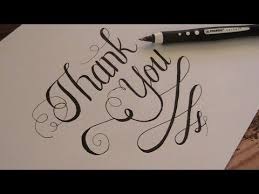|
|
| |
|
|
| |
|
|
|
|
| |
 |
| A thank you note
written in cursive. |
Cursive
Cursive (also known as script, among other names[a]) is
any style of penmanship in which some characters are
written joined together in a flowing manner, generally
for the purpose of making writing faster, in contrast to
block letters. Cursive handwriting is very functional,
and is intended to be used in everyday writing. In
addition, it is also used in art and calligraphy
hand-lettering. Formal cursive is generally joined, but
casual cursive is a combination of joins and pen lifts.
The writing style can be further divided as "looped",
"italic" or "connected".
The cursive method is used with many alphabets due to
infrequent pen lifting and beliefs that it increases
writing speed. In some alphabets, many or all letters in
a word are connected, sometimes making a word one single
complex stroke.
A study in 2013 discovered that speed of writing cursive
is the same as print, regardless of which handwriting
the child had learnt first. |
|
Descriptions
Cursive is a style of penmanship in which the symbols of
the language are written in a conjoined and/or flowing
manner, generally for the purpose of making writing
faster. This writing style is distinct from
"print-script" using block letters, in which the letters
of a word are unconnected and in Roman/Gothic
letter-form rather than joined-up script. Not all
cursive copybooks join all letters: formal cursive is
generally joined, but casual cursive is a combination of
joins and pen lifts. In the Arabic, Syriac, Latin, and
Cyrillic alphabets, many or all letters in a word are
connected (while other must not), sometimes making a
word one single complex stroke. In Hebrew cursive and
Roman cursive, the letters are not connected. In
Maharashtra, there is a version of cursive called 'Modi'. |
|
Origin
The origins of the cursive method are associated with
practical advantages of writing speed and infrequent
pen-lifting to accommodate the limitations of the quill.
Quills are fragile, easily broken, and will spatter
unless used properly. They also run out of ink faster
than most contemporary writing utensils. Steel dip pens
followed quills; they were sturdier, but still had some
limitations. The individuality of the provenance of a
document (see Signature) was a factor also, as opposed
to machine font. Cursive was also favored because the
writing tool was rarely taken off the paper. The term
cursive derives from Middle French cursif from Medieval
Latin cursivus, which literally means running. This term
in turn derives from Latin currere ("to run, hasten").
Although the use of cursive appeared to be on the
decline, it now seems to be coming back into use. |
|
|
|
|
|
|
|
|
|
|
|
|
|
|
|
|
|
|
Search Fun Easy English |
|
|
|
|
|
|
|
|
|
|
|
|
|
|
|
About
Contact
Copyright
Resources
Site Map |